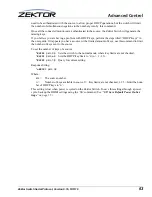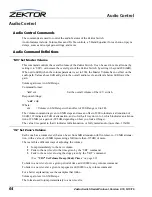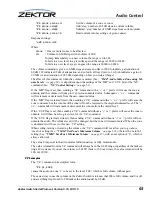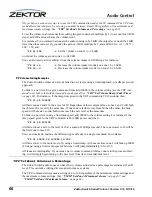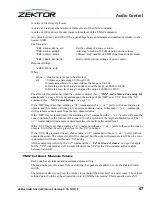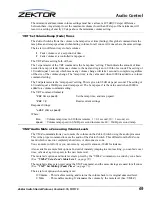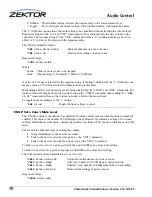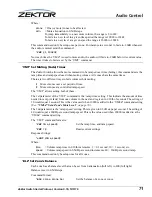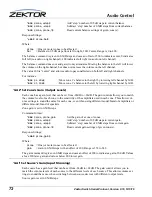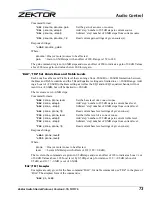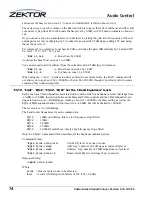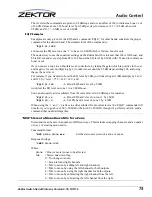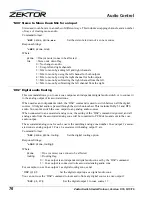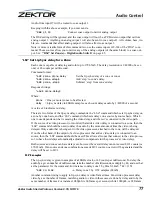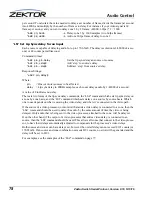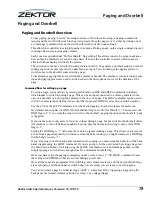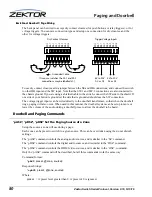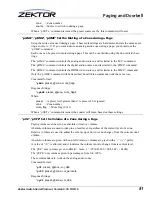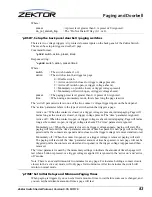
Zektor Switch Serial Protocol, Version 0.16, 5/13/16
77
Audio Control
Audio from input 17 will be routed to coax output 1.
Keeping with the above example, if you now send a:
^DRZ @1,1$
;Connect coax output to mirror analog output.
The DSZ setting will be ignored, and the coax output will now be a PCM-stereo output that mirrors
analog output 1. Anything on analog output 1 will also be sent to coax output 1. All volume, bass, tre-
ble, etc. commands that affect analog output 1 will also affect coax output 1.
Note: A more versatile form of this command is to use the source inputs 129-144 of the ‘DSZ’ com-
mand. These sources allow you to mirror any of the analog outputs (of the same block) to a coax out-
put. See: “
‘DSZ’ Set Zone(s) -- Digital Audio Switch
” on page 45.
‘LSZ’ Set Lip Sync delay for a Zone
Each zone is capable of delaying audio for up to 170.65mS. The delay resolution is 1/48000 of a sec-
ond, or 48 counts per millisecond.
Command format:
^LSZ @
zone
,@
zone
,
delay
Set the lip sync delay of a zone or zones.
^LSZ @
zone
,+
step
$
Add ‘step’ to zone’s delay.
^LSZ @
zone
,-
step
$
Subtract ‘step’ from zone’s delay.
Response Strings:
^=LSZ @
zone
,
delay
$
Where:
@
zone
= One (or more) zones to be affected.
delay
= Lip sync delay in 48KHz samples, each count delays audio by 1/48000 of a second.
A value of 0 indicates no delay.
There are two forms of the lip sync delay commands, the ‘LSZ’ command which sets lip sync delay on
a zone by zone basis, and the ‘LSI’ command which sets delays on a source by source basis. Which
one to use depends on what is causing the video delay, and where it’s connected in the video path.
If the source of a video processor (or monitor) that adds a video delay is connected to a zone, then the
‘LSZ’ command should be used to delay the audio by the same amount of time the video is being
delayed. Only audio that is being sent to the video processor, attached to the zone, will be delayed.
If on the other hand, if the output of a video processor that adds a video delay, is connected to an
source, then the ‘LSI’ command should be used. This allows all zones that connect to the video proces-
sor, to have their delays automatically adjusted to compensate for the processor’s video delays.
Both sources and zones can have delays set, however the overall delay cannot exceed 8191 counts (or
170.65mS). If an source and zone combination exceeds 8191 counts, no error will be generated and the
delay will be set to 8191.
‘LSZ’ Examples
The lip sync delay is given in samples of a 48KHz clock, or 48 counts per millisecond. To delay the
audio by a given number of milliseconds, take the number of milliseconds, multiply by 48, and use that
as the parameter for the command. For instance to delay zone 3 by 24mS: 24mS * 48 = 1152
^LSZ @3,1152
->
Delay zone 3 by 1152 samples (24mS)
Another common timing to apply to lip sync delay is video frame times. Most video processor delay
video by a set number of frames, matching audio to video in these cases is done by delay audio by the
same number of frames. For instance 1080p60, is 60 frames per second, while 1080p24, is 24 frames

